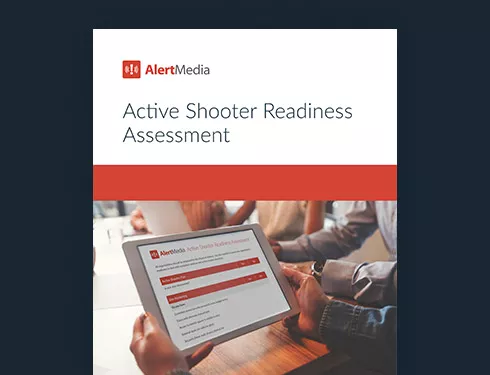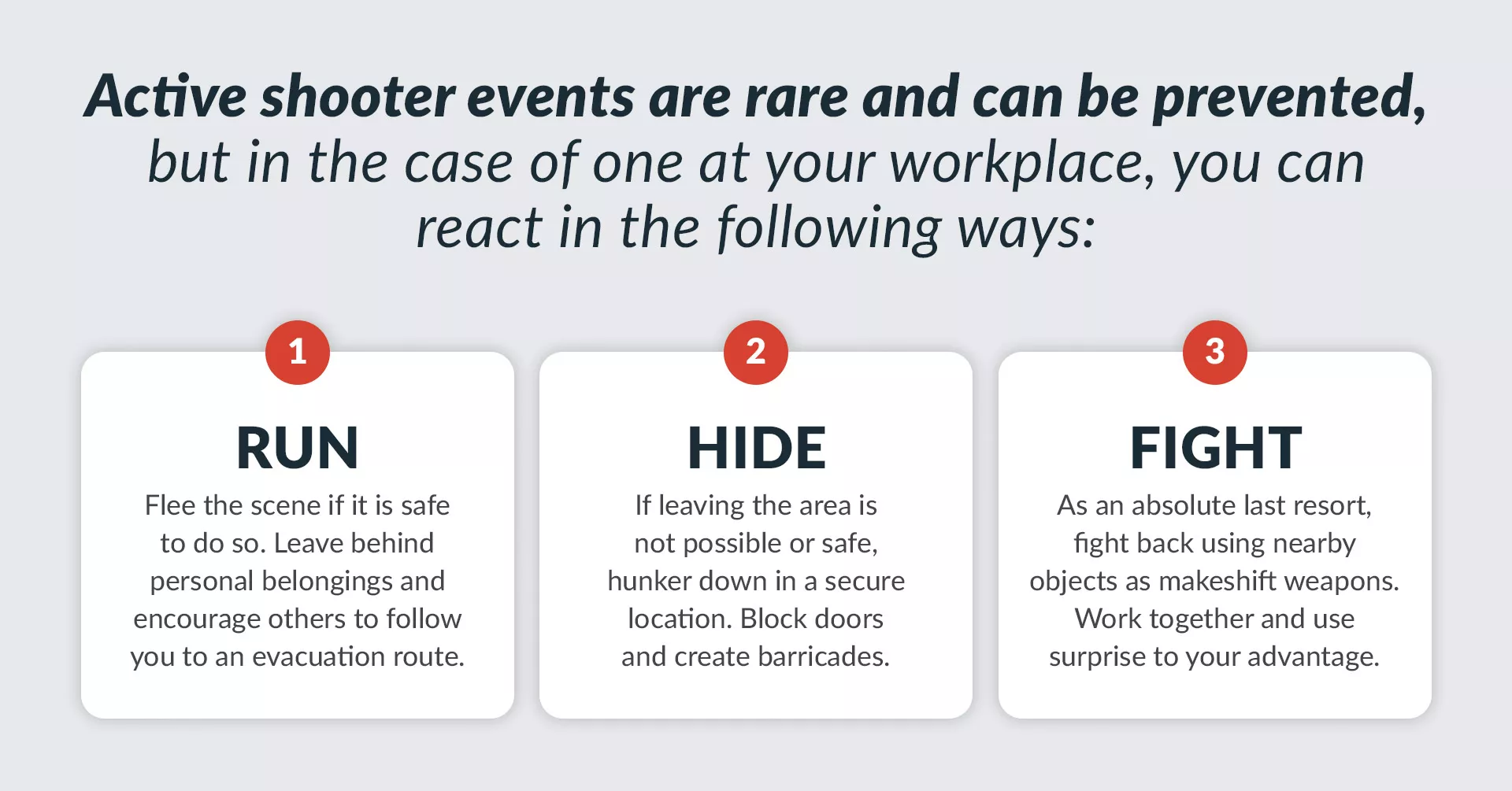
Active Shooter Preparedness: How to Protect Your Business [+ Checklist]
Active shooter preparedness should be a priority for every company concerned about employee safety. Here are some steps you can take to protect your people.

It’s a scenario no business wants to think about: an active shooter on the premises. Yet, active shooter incidents remain a concern for millions of employees and impact thousands of lives each year, stressing the importance of understanding the risks and formulating risk mitigation strategies.
Each year the FBI provides a full account of documented active shooter incidents in the U.S., shedding light on where and when they occur. Their data suggests that while some industries face greater risk than others, all organizations now face an unfortunate reality: no company is exempt from the potential threat of an act of violence occurring on their premises.
In this post, we’ll analyze the FBI’s data to understand the risk factors businesses should consider when formulating an active shooter preparedness strategy and discuss emergency management best practices for before, during, and after an incident occurs.
What Is an Active Shooter?
Not all gun-related violence is considered an active shooter event. The FBI defines an active shooter incident as “one or more individuals actively engaged in killing or attempting to kill people in a populated area.” Given the high volume of gun-related incidents, the FBI reports only on incidents involving the use of a firearm (as opposed to other types of weapons) that meet one or more of the following criteria:
- Incidents occurring in public places
- Incidents occurring at more than one location
- Incidents where the shooter’s actions were not the result of another crime
- Mass casualty events
- Shootings that appear to be spontaneous acts
- Incidents where the shooter appeared to methodically search for victims
- Shootings that appear to focus on individuals, not buildings or objects
Active Shooter Statistics
An active shooter situation can occur anywhere, but the FBI data also shows that certain types of organizations are at a greater risk. From 2000 to 2019, 333 active shooter incidents occurred in 43 different states (and the District of Columbia), collectively resulting in 2,851 casualties. Of the 333 incidents, 96 (29%) took place at a business location open to pedestrian traffic—by far the highest percentage.
 Source: FBI, Active Shooter Incidents 20-Year Review, 2000-2019
Source: FBI, Active Shooter Incidents 20-Year Review, 2000-2019Tragically, according to U.S. Department of Homeland Security and FBI data, active shooter incidents continue to rise across the country, with 40 incidents in 2020 alone. Of these incidents, 24 (60%) occurred in a business environment.
There is no way to predict when or where an active shooter incident will occur. For that reason, it’s critical that organizations prepare ahead of time, ensure employees are equipped with appropriate training and tools, and have a reliable method of reaching those in harm’s way, should they be involved in an active shooter scenario. Below, we’ll cover best practices for each preparedness strategy.
Active Shooter Preparedness Strategies
Whether an attack is targeted or random, having an effective active shooter response plan in place is the first line of defense. The following emergency preparedness framework was developed by the U.S. Department of Justice and aligns with guidance from the Department of Homeland Security (DHS). It consists of five main areas of active shooter preparedness: Prevention, Protection, Mitigation, Response, and Recovery.
1. Prevention
Even the best-laid plans can’t guarantee absolute safety. However, there are factors every business should consider as they look for ways to prevent active shooter events.
Organizations should implement employee screening and background checks for new hires. Additionally, fostering a positive, inclusive work environment and treating every employee with compassion and respect can often curtail the behaviors that lead to an active shooter event. Finally, DHS recommends that organizations create systems for reporting signs of potentially violent behavior and ensure employees have access to training videos detailing what to do if they witness any type of workplace violence.
Additionally, while there are no clear-cut indicators that a current or past employee might engage in a violent act, here are some red flags to look for.
Common pre-attack behaviors include:
- Increased use of alcohol and/or illegal drugs
- Signs of depression, withdrawal, or severe mood swings
- Resistance and overreaction to changes in policy or procedures
- Behavior suggesting paranoia
- A sudden decline in mental health
- History of aggression toward authority figures
- An increase in unsolicited comments about firearms, weapons, and violent crimes
- Expressing empathy with other individuals committing violence
- A fascination with past shootings/mass attacks
- A traumatic life event such as a death, breakup/divorce, or loss of employment
- Being the victim of bullying in the workplace
These warning signs are by no means an exhaustive list, and they certainly don’t always suggest an impending threat. But staying aware of some common behaviors could potentially prevent an attack.
2. Protection
In the context of active shooter preparedness, protection refers to the ongoing actions businesses can take to safeguard their people and property.
The Occupational Safety and Health Administration (OSHA) suggests developing a thorough Emergency Operation Plan prior to an incident occurring. This includes ensuring you have an emergency communication system in place to immediately notify employees of an incident.
Considering that the average length of an active shooter incident is 12.5 minutes, every second counts when activating your emergency response. Targeted acts of violence can escalate quickly, so you need to be ready to deal with the situation before local law enforcement is on the scene. 60% of active shooter events conclude by the time police arrive. Keeping your people informed about unfolding events can ultimately save lives.
3. Mitigation
This stage differs from prevention because it focuses on detecting a potential threat and limiting the damage of an attack. The U.S. Federal Emergency Management Agency (FEMA) defines mitigation techniques as “the capabilities necessary to eliminate or reduce the loss of life and property damage by lessening the impact of an incident.” While it might feel like an active shooter scenario is out of your control, there are precautionary measures every business can take to reduce the likelihood an incident will occur.
First, conduct a thorough business threat assessment and designate a threat assessment team to document potential danger. Your team should include key stakeholders who have been thoroughly trained in threat assessment and management. This group will also work with law enforcement to identify potential threats and protect your people against harm. A physical threat intelligence and monitoring solution can also help you rapidly detect incidents near your people or business locations and identify employees in harm’s way.
Ultimately, the goal of mitigation is to err on the side of caution and utilize the resources at your disposal. Your goal during this stage should be to shield your people from danger and limit the damage of an active shooter attack.
4. Response
When an act of workplace violence does occur, how your business responds is critical to the success of your recovery. Your response plan should highlight how to stabilize the incident, establish a safe environment, communicate with your people, and ultimately transition into recovery mode.
Empower your employees
The first step of responding to an active shooter situation is sounding the alarm when something happens. Employees may not spot or can even ignore hints of imminent danger and fail to alert the workplace. They should be trained and provided with the tools to push a button or dial an emergency code to ensure that both employees and first responders like the police department are notified immediately. Even if the situation turns out to be a false alarm, empowering your employees to act on any possible threat can help save many lives.
Training: Run, hide, fight
During an active shooter scenario, the most commonly taught reaction strategy involves three options: Run, Hide, or Fight. Fleeing the situation should be the first course of action. Workplace active shooter training should focus on mapping out evacuation routes ahead of time. Staff should also be reminded to leave behind personal items, avoid escalators and elevators, and call 911 once safe. An active shooter drill outlining specific steps will help to minimize panic.
If running isn’t possible, sheltering in a secure hiding place is a second option. Your active shooter response plan should instruct your people to find a room with few windows and shut off the lights. They should lock the door, barricade it with heavy furniture, keep quiet, and remain hidden until identifiable law enforcement has given the all-clear signal.
Finally, as a last resort, employees might be forced to incapacitate the assailant. While nobody wants to think about confrontation with a violent individual, there might be no other choice. Employees should make use of common office items as weapons (such as chairs or fire extinguishers) and consider the benefit of force in numbers, speed, and surprise.

Communication is vital
When it comes to active shooter preparedness, one of the most impactful actions a business can take is investing in reliable, easy-to-use mass notification software. Sending out communications that relay vital information is perhaps the most effective way to keep your people safe.
An emergency communication system should meet the following criteria:
- An intuitive interface that allows you to send out alerts with ease
- Multichannel notifications so that urgent information reaches employees as quickly as possible via whichever communication channels are available to them
- Two-way messaging to ensure employees can reply with status updates or request assistance
- Support for surveys and wellness checks to quickly survey employees and confirm if they’re safe
- Communication templates designed to accelerate emergency response times
- Mobile apps so safety leaders can initiate a response anywhere, from any device
In reality, it is unlikely that everyone will remain calm in the midst of a frightening attack. But the faster your people are aware of the situation, the more likely everyone can get to safety and begin the recovery process.
5. Recovery
The immediate aftermath of an active shooter incident will likely be a confusing time. Misinformation can lead to delayed recovery and further trauma, and employees may require more assistance than your human resources team is staffed to provide.
This is also where timely communication can help others process, seek support, and ultimately recover from the trauma they’ve endured.
Some emergency notification system providers offer a central hub (such as an event page) where a company can consolidate crisis details, post current video/photos, and communicate resolutions. This can be especially useful in expediting the recovery process and keeping everyone aware of a quickly unfolding situation.
Longer-term recovery can be broken down into four distinct areas: services, physical, financial, and emotional/psychological. Your emergency plan should determine who has authority to close and reopen the business, how to document damage assessments, sources for relief funding, and where/how psychological first aid will be provided.As organizations plan for both the Response and Recovery phases, it’s helpful to adopt the principles of FEMA’s National Incident Management System. This will help everyone share common terminology, assign roles, and define responsibilities as businesses strive to regain continuity and support their people during the vulnerable recovery process.
Active Shooter Action Plan
Every organization should make sure that its active shooter preparedness efforts are tailored to its unique needs and concerns. For example, a company that is open to the public will be exposed to different active shooter risks than a company that runs a warehouse only accessible to employees.
Regardless of a particular organization’s circumstances, there are some commonalities among all active shooter action plans. Let’s walk through the parts of an active shooter action plan template to give you a better idea of what these look like.
The Active Shooter Emergency Action Plan Template
Here are the steps to creating your own active shooter response plan:
- Identify key people and teams who are responsible for crisis management, internal communications, business continuity, and other related roles. List their position, responsibilities, and contact information.
- Document lockdown procedures and determine who is responsible for initiating said lockdowns.
- List lockdown procedures so that everyone knows what’s expected of them ahead of time.
- Create an evacuation plan and put people in charge of keeping that plan up-to-date. They should also make sure that evacuation routes and rally points are clear and safe.
- Write emergency notifications ahead of time so that messaging is ready to go in the event of a shooter.
- Create a plan to disseminate information, and be sure to consider visitors as well as employees, non-English speakers, and those with impaired vision or sight. Make sure that you have up-to-date contact information for your employees and partners.
- Designate someone to coordinate with first responders so that they are able to react quickly and effectively to the active shooter. Make sure they know everything about the situation and the physical layout of the area, and clear the way for them to do their jobs. It is important to assign these duties to a person or group who knows they are responsible for them. In an active shooter situation, effectively working with the authorities can save lives.
- Train up your people so they know how to react to an active shooter. This can include workplace active shooter training such as the ubiquitous “Run, Hide, Fight” model or the proper way to engage with responding police officers and emergency medical services. You should train regularly and ensure all employees go through it.
The United States Cybersecurity and Infrastructure Security Agency (CISA) has a handy template that can get you started with creating your own active shooter emergency action plan. But remember: What works for one organization might not make sense for yours. It’s crucial that you turn a critical eye toward your plan and discover what works and what might not.
Additional Resources
The FBI has a number of publicly available training videos for businesses meant to help both safety leaders and employees understand how to best protect themselves during an active shooter event. Several institutions, including AlertMedia, also provide free active shooter resources, such as communication templates for conveying urgent information to employees. The United States Department of Homeland Security has a booklet that is a great jumping-off point for understanding active shooter events and ways they can be managed and averted.
Prepare Your Business
By learning how to prepare for active shooter scenarios, you have taken huge steps to protect your company and employees. Continue to strengthen your active shooter response plan by using our Active Shooter Readiness Assessment. Ensure that you have considered site hardening, communication, training, policy, and threat reporting to feel confident that you have done everything in your power to protect your employees.
Nobody wants to consider the possibility of an active shooter or violent workplace incident happening to them. But thoughtful preparation can truly save lives.



![4 Steps to Conduct a Business Threat Assessment [+ Template]](https://www.alertmedia.com/wp-content/uploads/2022/07/Blog-Image-Business-Threat-Assessment-V1.jpg)
